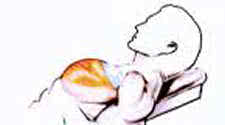Pectoral Range of Motion - Dumbbell vs Barbell vs Machine Bench Press

The Final Verdict for the Optimal Bench Presses Movement
Which is better, dumbbell or barbell bench presses?
To answer that question, let's first analyze the pecs' range of motion. Remember, POF is geared toward training each muscle through it's
full range of motion for complete development, so that's the best place to start when analyzing any exercise- or target bodypart.
In the pecs' full-stretch position your hands are wide and your elbows are slightly bent and behind your torso, with your arms perpendicular
to the torso, as in the bottom of a dumbbell fly. The completely contracted position occurs when your arms are out in front of your chest,
perpendicular to the torso with the hands together or, better yet, with your arms crossed at mid forearm. If you can simulate that range with
a pressing movement wide at the bottom, narrow at the top you get synergy, stretch and contraction, and you've found a great pec exercise.
Hammer Strength and MedX have done a good job of working this range of motion into their chest press machines. In both cases you begin with
your hands wide, close to a full pec stretch, and as you press, your hands move inward until they're somewhat narrower at the finish, which
gets you close to the pecs' contracted position. The MedX chest press actually forces your hands together at the end of the movement, which
forces an intense pec contraction.
In contrast, when you do bench presses with a bar, your hands stay the same distance apart throughout the range of motion if you start a
rep with a wide grip, you end it with a wide grip. While you may get close to the pecs' stretch position with a wide-grip bench press, you
completely miss their contracted position because your hands stay wide at the top of the movement.
Based on the above discussion, if you don't have access to Hammer or MedX machines, dumbbells appear to be the better choice. With dumbbells
you can go from a wide grip to narrow, your range of motion is a little better because your chest isn't the stopping point, and you can even
turn your hands to a palms- facing position at the top of each rep to get them close enough for a good pec squeeze. Don't pin the blue ribbon
on dumbbells just yet, however. There are some problems.
The biggest negative with dumbbells is that you're constantly working to balance them, which can shift a lot of the stress to the deltoids.
Plus, reclining on a bench with a heavy dumbbell in each hand is somewhat difficult, not to mention dangerous, especially if you're holding
more than 100 pounds in each hand.
For these reasons dumbbell bench presses really aren't that much better than the barbell variety. It's a trade-off. While your hands can't go
from wide to narrow when you're pressing with a bar, at least you don't have to struggle as much to get into position, make an awkward unilateral
movement and maintain balance and control. With a bar you get better coordination and synergy so that you can move more weight.
By all means alternate between a bar and dumbbells for variety, but don't think one is better than the other. They both have their pros and cons.
One thing is certain, however: Whether you're benching with a bar or dumbbells, you should always include cable crossovers in your routine, going
from full stretch to where your arms cross at your wrists for complete contraction. A bench press-crossover-combo workout ensures that you train
your pecs with maximum synergy with the bench press and from full stretch to complete contraction with the crossovers-all in all, a total
range-of-motion pec-building program.